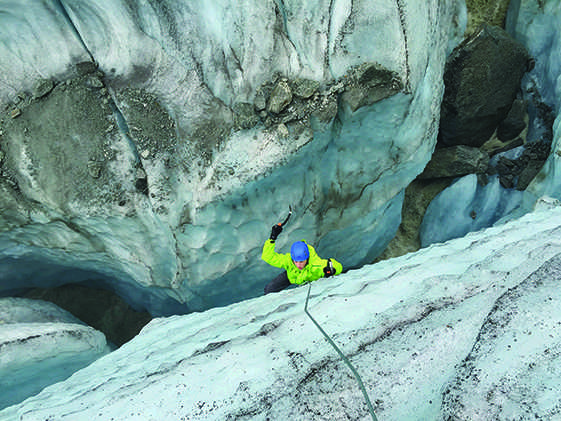The RUSH
HOW CAN ONE LITTLE HORMONE CHANGE SO MUCH? READ ON TO UNCOVER THE COMPLEXITIES OF ADRENALINE AND WHAT IT CAN DO FOR YOU.

Andy Gibson (’16) participates in ice-climbing
February 18, 2016
You’ve heard awe-inspiring stories of mothers lifting cars to save their trapped children and people cliff jumping into dangerous waters, which sounds absolutely crazy, but it’s all due to a little rush of a simple hormone. Yes, a little hormone that can give superhuman strength and trigger our fight or flight responses. A single hormone that people would risk their lives for. Adrenaline.
When put in these fearful or stressful situations , your body goes through a process to allow you to make a quick decision.
During a high-stress situation, your body begins by activating the hypothalamus. The hypothalamus is responsible for maintaining physiological balance, which is more commonly understood to be the balance between stress and relaxation. The hypothalamus has direct connection to the adrenal medulla, which is the center of the adrenal glands, according to Jordan Gaines Lewis, an award winning science communicator. Adrenaline is released from the adrenal gland causing blood vessels to contract, which then lets the blood be re-directed toward major muscle groups like the heart and lungs, which stimulates the fight or flight response. For those unaware of what this response prompts: it creates air passages to expand to provide the muscles with the oxygen they need to either fight danger or flee according to Hormone Health Network.
Basically, adrenaline can affect a lot of aspects of your body. Obviously, there can be a significant increase in strength and performance, but there are more signs of this hormone rushing through your body. More noticeable effects that adrenaline has on the body may include increased breathing and heart rate, sweaty or clammy hands, and often heightened awareness, just to name a few.
If you are still confused about how this gives us superhuman strength in dire times, here’s a closer look. According to Lewis, humans typically use a small percentage of our muscle’s total capability. Once adrenaline is pumped into our blood circulation, blood is diverted from other areas of our body and pushed towards our muscles. This also allows more oxygen to reach our muscles. On top of this, adrenaline facilitates our body’s stored energy source and converts it to usable glucose. This combination increasingly strengthens our muscles beyond the normal levels.
Isabel Black (‘17) has first-hand encountered the instant high of an adrenaline rush when she was given the opportunity to skydive in the Swiss Alps.
“When it was my turn to jump out of the helicopter, I had no butterflies. We jumped out and immediately did a backflip, and the rush was instant,” Black said. “I instantly got a high, a rush of adrenaline and couldn’t help but smile because of how fun it was. There’s no feeling like it in the world.”
Although adrenaline has it’s positive effects, there are also dangers with such a strong hormone. According to ABC News, adrenaline makes pain seemingly disappear, which sounds nice in theory, however, it can also be a danger to one’s body. If and when an athlete gets an injury, it’s important to stop, rest, and let the injury heal itself. In a game setting, adrenaline often masks the pain caused by an injury, and because of this, an athlete may continue to play on the injury, which may further the severity of that injury.
In the competitive sports atmosphere of Paly, injuries are not uncommon, but many of these students also play through such injuries. On occasion, this may be harmless to an athlete. But in other cases, playing through a serious injury can cause more damage and even force the athlete to be out longer, or end a career. Adrenaline plays a large part in an athlete’s ability to play through injuries.
“I dislocated my shoulder while running with the ball, my left arm was grabbed and the guy just happened to not let go and it came out,” Dami Bolarinwa (‘16) said. “I noticed it really quickly ,put it back in, and continued playing. I think adrenaline affects everyone in games.”
Adrenaline isn’t just a hormone athletes have, everyone has access and can experience its effects. The human body produces adrenaline after the brain receives a message that we are encountering a stressful situation. These bursts of adrenaline can range from stress caused by a test you’re taking in twenty minutes, to the fact that you’re getting chased by a bear (although probably unlikely).
But, in an athletic sense, an athlete is able to do things in certain situations that they would not normally be able to do.
“I feel the numbing feeling, I block out the pain and I continue to play and fight for each ball, each tackle, anything to benefit my team,” Bolarinwa said. “I mentally just try to focus on anticipating the next play. I block it all out until the game is over.”
Research echos Bolarinwa’s thoughts. Time after time, adrenaline has been shown to block out a person’s ability to detect both pain, and the severity of the pain.
Adrenaline can also be used in extreme medical situations. Although not a typical medical treatment, an injection can be given in the event of a sudden stop of the heart (cardiac arrest). The adrenaline can stimulate the heart to restart and begin beating strongly. According to MyDr.com, nursing staffs and paramedics can give the injection in an emergency situation.
Although, adrenaline’s medical use does not exactly correlate with the natural effect that the hormone has on your body. A laboratory setting cannot replicate the hormonal effects that natural adrenaline produces in high stress situations mainly due to the fact that no controlled situation is likely to induce such a feeling.
Practical medical uses of adrenaline have been seen, but what about when someone just wants to feel a rush? Like that of a drug, adrenaline rushes can cause a similar blood-warming, invincible surge through the human body. And like a drug addict, there are adrenaline junkies throughout the world as well. Adrenaline is a natural reaction which can be achieved during a high stress situation. And through this, we see the epitome of adrenaline junkies: seeking high stress and dangerous situations for the thrill of a rush.
According to FitDay, an adrenaline junkie is “a person addicted to the thrill of the adrenaline rush.” For an adrenaline junkie, sports are a very common ground in the search of a rush. From skydiving to mountain biking, these thrill-seekers look to partake in any activity that provides a larger than normal amount of danger or risk.
Here at Paly, many students engage in extreme-sports and adventure-seeking opportunities. From skidiving to dirt-biking and even ice-climbing, these tenacious thrill-seekers have experinced life-changing events through these adrenaline rushes.
Itai Palmon (‘16) went on a dirt-biking trip in Baja, California. Palmon started a little south of Tijuana and traveled six hours down the coast on his first day.
“If I had too much [adrenaline], I’d be jittery; if I didn’t have enough, I’d be too slow, too calm,” Palmon said. “The perfect amount was when I could be completely focused and think quickly, while also having control over my body.”
On day two, he biked a total of 10 hours into the desert and up a mountain to an area called Mike’s Sky Ranch. He completed his journey down the mountain and completed his journey north towards San Diego on day three.
Although the whole adventure required a lot of adrenaline, Palmon encountered a more stressful situation than the average dirt-biking scares. He was riding in silt, which creates conditions similar to sand. When in silt, the front wheel of a dirt bike has a harder time staying straight. On the ride, his bike tipped over a bump in a deep patch of silt.
“As the bike was falling I remembered my dad explaining that we need to wear high boots so that if we need to put out a leg to hold our weight and that of the bike, we won’t break our ankles,” Palmon said. “So as the bike was falling, I quickly put out my leg and pushed the bike back up. There’s no way I could have moved that quickly without adrenaline.”
Like any high, the effects of adrenaline wear off after a sustained period of time. Unfortunately, the signs of adrenaline addiction are not as clear cut and easy to read as those stemming from a drug addiction. An adrenaline addict can very easily fill their life with drama and toxic conditions rather than ironically, the safe outlet of extreme sports. The border of addiction and attraction is slim. An addict feels the same rush from manufactured stress, so they lose the attraction to the natural feeling of an extreme sport.
Why can’t we feel like superheroes all the time then? Lifting incredibly heavy objects is not exactly considered “healthy”. Realistically, our muscles are not built for that kind of strenuous lifting. Secondly, this extreme amount of stress over a long period of time would severely damage us. Stress makes humans more susceptible to illness and infection.
But, how does all of this tie together in a sports sense? Athletes, in correlation, also seek the thrill of their athletic competition. And when it comes down to it, playing through a little pain for the end result does not phase them in the heat of the moment.
Basketball player, Miles Tention (‘17) has endured a back injury on and off for some time now, but has not reported feeling pain since the summer of 2015, until recently. As starting point guard for the Vikings, Tention has sacrificed his body in the event of a game. In the most recent basketball quad night againt Gunn, he was escorted off the court in Titan gym and taken to the training room for further evaluation. For this young athlete, it takes a lot of pain in order for him to give in and stop playing.
“I play through the pain because I’ve worked so hard to get to this point; I can’t let myself down,” Tention said. “I’ve worked with my teammates for these games all year, so I try not to let an injury slow me down and stop myself and my teammates from achieving our goals in the season. “Unless I can’t walk, I’m going to play. So I played.”
Like Tention and Bolarinwa, many other dedicated athletes have been taught, “Play through the pain.” In 2014, Elizabeth Murray wrote an article for the Health and Wellness section of Today on teenagers playing through pain. A female field hockey player was struck in the head with a stick and blacked out, but, like many athletes, only had one thing on her mind.
“The only thought in my mind was getting back in the game,” the athlete said. “I thought I had to be tough. I thought I had to go back in because we were losing and I needed to support my team.”
Later in the night the athlete was taken to the hospital and suffered permanent brain damage. Unfortunately, her story brings to light millions of stories from millions of other athletes playing through an injury with a little help from adrenaline. According to Safe Kids Worldwide, one child is taken to the emergency room every 25 seconds for a sports injury.
Safe Kids Worldwide also conducted a study of 3,000 athletes, coaches and parents, and revealed astonishing facts to this phenomenon. 42% kids reported downplaying or hide an injury so they could continue playing while 53% of coaches disclosed feeling pressured to put an injured player back in the game.
So, is adrenaline good or bad? Healthy or unhealthy? As in any case, adrenaline has its positive and negative effects on the bodies of athletes. A little bit lights a fire underneath you, but too much may cause detrimental problems to a person’s health. From adrenaline junkies, to hard core athletes, to the rest of us normal people, adrenaline affects everyone and it is important to understand the impacts this hormone has on us and our bodies.
“When the stakes are high you want to play your best and win not just for you, but for your team, for the fans that came out to support you,” Bolarinwa said. “It affects everything.” <<<










